Of all of the many thousands of vertebrate species, fish being the most numerous, which one is the most famous for preying on its own?
Outdoors
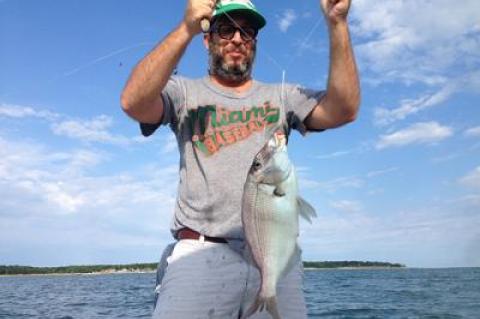 Fireworks on the Water
Fireworks on the WaterThere was a lot of noise going on. While there were plenty of boisterous and colorful fireworks blasting off into the night sky during the extended July 4 holiday weekend, the local fishing scene also witnessed its own cacophony of activity on several fronts, as angler participation leaped into full summer mode. Some much-appreciated warm and toasty weather did not dissuade many from either jumping in the bay or even the still-chilly ocean waters for a nice, refreshing dip, or from baiting up a fluke or porgy hook for a chance at a nice holiday dinner.
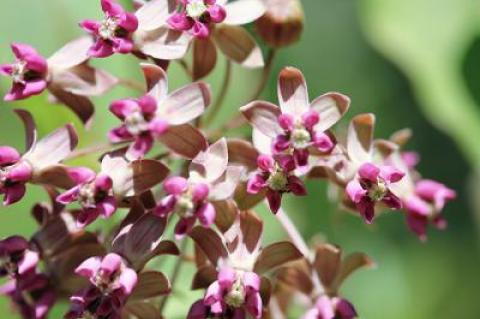 Nature Notes: Good News and Bad
Nature Notes: Good News and BadTry to look beyond the madding crowd. There’s a lot going on in the world of nature, all of it free of charge. North America’s tiniest hummingbird, the calliope from the Pacific Northwest, has come to nectar alongside a ruby-throated male at Joanne Dittmar’s house in Springs on the bay just west of Hog Creek. Sibley defines it as an “accidental.” The ruby-throat is our tiniest bird species; just imagine how hard it would be to see a bird two-thirds its size with the naked eye as it whizzed by.
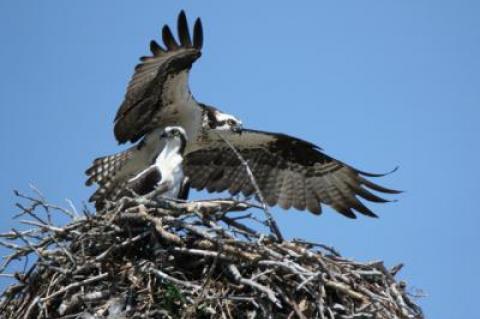 Nature Notes: It’s Not for the Romance
Nature Notes: It’s Not for the RomanceThere’s an old saw that says “there’s more than one way to skin a cat.” It doesn’t actually have to do with removing the pelts from cats, thank God, but more with alternative ways of getting something done that needs to be done. In humankind as in nature, just about every method to get a given thing done has been tried. Some methods fail outright, some work for a while, then others that are more durable and efficient replace them; a few work forever with little change over countless eons, thus the horseshoe crab.
 Time to Follow the Sun
Time to Follow the SunAs the season changes from spring to summer, it’s always been a bit hard for me to fathom that our exposure to natural daylight is already on the downhill. A sunrise of 5:15 a.m. on June 21 in Montauk is 5:18 a.m. a week later. It’s only a three-minute difference, but the daylight does begin to erode rather quickly.
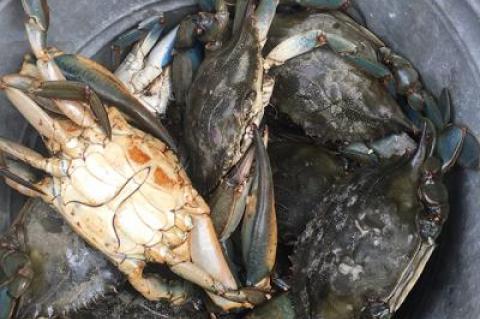 Gonna Need a Bigger Boat
Gonna Need a Bigger BoatMy memory of watching the movie “Jaws” for the first time shortly after its release in June of 1975 still stands clear in my mind. Its effect on me, and others at the time, was profound. Since that day, I’ve lost count of how many dozens of times I have seen it on TV, and yet I still get the chills watching several of its scenes.
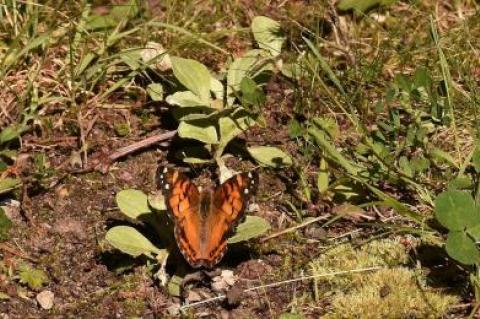 Nature Notes: A Treasure Trove
Nature Notes: A Treasure TroveThe South Fork of Long Island has hundreds of beaches, woodland trails, sidewalks, and other stretches for walking and communing with nature.
On the South Fork it would seem that the stars get dimmer and dimmer with each passing year.
 Nature Notes: Our Own Highway 61
Nature Notes: Our Own Highway 61I went out looking for signs of gypsy moth infestations on Sunday, exploring the oak-hickory and oak-pine forests along the major Sag Harbor, Bridgehampton, Wainscott, and Northwest Woods roads.
Sunday night was cloudy and cool with a slight breeze. I set out for a second night on the trail of the once common but now rare whippoorwill. Last Thursday the Noyac and Bridgehampton hills were under my microscope. Sunday night it would be Northwest Woods in East Hampton and Napeague. I didn’t hear a single whippoorwill the first night. I was hoping that it would be a different story the second time out.
 Nature Notes: Color Schemes
Nature Notes: Color SchemesThe summer birds are back in full force. Most are day birds, but some are nocturnal — the owls and the nightjars such as the nighthawk and whippoorwill.
 Ramit Tandon Makes a Splash at Squash Tourney
Ramit Tandon Makes a Splash at Squash TourneyRamit Tandon, a Columbia University graduate who left Wall Street for the pro tour recently, swept through the S.Y.S. Open squash tournament this past week, defeating a fellow Indian, Kush Kumar, a member of Trinity College’s national-championship team, 11-3, 11-2, 11-3 in Sunday’s final.
 Nature Notes: Widows and Recluses
Nature Notes: Widows and ReclusesWhen I was a boy growing up in Mattituck I poked around everywhere and at everything, collecting many of the things I found, be they animate or inanimate, or, as they say in Twenty Questions, “animal, vegetable, or mineral.”
 Nature Notes: Eelgrass Imperiled
Nature Notes: Eelgrass ImperiledAre there flowering plants that live in the seas? Yes, they are called sea grasses because, like land grasses, they are monocots, plants that only display a single leaf upon emerging from the seed.
 Nature Notes: Spring As I Remember It
Nature Notes: Spring As I Remember ItIt’s 3 p.m. on Sunday and the sun is shining in full glory following three days of cloudy rainy weather. The robins and cardinals are singing their territorial songs, the trees are beginning to leaf out, the red maples are flowering, and the scarlet and black oaks are following in their stead. By the time this goes to press, the shads and beach plums will be in bloom, to be followed by the dogwoods, then the mountain laurels. It is spring as I remember it.
 Nature Notes: Birds of Early Spring
Nature Notes: Birds of Early SpringIt was, indeed, a very rough March. But April is here and things are starting to pop. One sign of spring is the number of male robins on the greening shoulders along roads. Why they hit these shoulders first before the lawns is a question that has been nagging me for years, but that’s the way it is. On Sunday afternoon along Scuttlehole Road in Bridgehampton there were several, all males, of course. Females usually return several days after the males.
I’m in my 80s and spend a good deal of time thinking about the 1980s, when all sorts of things for the good happened on the South Fork, North Fork, and Shelter Island. And yes, there were many bad things to overcome.
From long before our kindergarten years, the one thing that we all know for certain is that there is life on Earth, and we are immersed in it. In fact, according to the latest findings by scientists examining four-billion-year-old rocks on the shores of Hudson Bay, spiral-tubular minuscule life forms, early bacteria, have been around that long or longer.
 Nature Notes: Raptor Rapture
Nature Notes: Raptor RaptureI was born in a house next to my grandfather’s chicken farm in Mattituck, across the bay. White leghorn chickens may have been the first bird species I opened my eyes to, the first bird species I came to know intimately. Before someone coined the term “free-range chickens” in the late 1900s, that’s what they were, free-range. They ran freely over the expanse of old fields and gardens surrounding my boyhood area, feeding and carrying on as chickens left to their own devices do. At night they either roosted on tree branches or in chicken coops on rails.
Here’s where we get our electric energy from: hydroelectric dams, nuclear power plants, the burning of fossil fuels (coal, oil, natural gas), subterranean heat sources, the sun, wind, and hydrogen.
You’re spinning, I’m spinning, we’re all spinning. Everything is in motion. If you are standing in an island in an ocean transected by the Equator, you are moving easterly at more than 1,000 miles per hour. You just don’t feel it or notice it because the island, the water surrounding it, and everything on it are moving at the same speed. If you are standing upright and motionless on one of the poles, north or south, you are near stationary, except that you turn completely around once every 24 hours. From infancy to old age, you and I, assuming that we have been in the same neighborhood all of these years, have been moving easterly at almost the same speed, but not exactly.
When I dropped out of Cornell University for the second time in 1957 I was about to be drafted. We were not at war then, having settled the Korean police action some four years earlier, but, nevertheless, I didn’t think I was cut out for the infantry so I enlisted. I wanted to go into intelligence so I took my chances on getting into the United States Army Language School in Monterey, Calif. I landed a slot — the last available — in Russian. I thought I would be sent to Europe at the end of the course, but instead I boarded a troop ship in San Francisco, sailed out under the Golden Gate Bridge, and headed for Japan.
 Nature Notes: Feed the Birds, and the Soul
Nature Notes: Feed the Birds, and the SoulWe are solidly into winter. My yard is covered with 11 inches of snow thanks to the back-to-back snowstorms of last week. Noyac Bay, 100 feet to the north, is beginning to freeze over, and it will, there being not a wisp of a breeze for several hours now.
This the last weekly column of the year 2016, and I decided to write a little bit about my peculiar daily data-taking habits, which may come to an end one day soon. After Saturday I will begin saving a few trees and a little time.
You may remember the R & B group Earth, Wind, and Fire. The name contains two of the classic Greek primary elements, but leaves out the third, water. In fact in googling pop music groups over the past 60 years, I can’t find any containing the word water. Yet, the more we know the more we learn — and most often after the fact — how important water is to the Earth and life. Some of the 10 to 20 million species recorded thus far in the world can survive without air; none can survive without water.
 Nature Notes: The Great Bunker Stampede
Nature Notes: The Great Bunker StampedeNapeague was once famous for its bunker factory, the Smith Meal Company. Local fishermen purse-seined up menhaden by the ton and unloaded them at that menhaden reduction plant where they were turned into fishmeal.
Pamela Rosenthal, who lives in the hills southwest of Three Mile Harbor, called the other day. She found a spider living on a toy that was left in the yard for some time. She was concerned that it might be a black widow, as it was black. She said it had two red spots on the back, but it didn’t have the telltale red “hourglass.”
Having worked as the environmental protection and natural resources director for East Hampton Town for a long time, every so often I ride through the roads to see how the town and its village and hamlets are faring. Naturally, I check out past carnages to see if there have been any redemptions of sorts and, happily, in most cases there have been.
 Nature Notes: Loners and Flockers
Nature Notes: Loners and FlockersYesterday, while I was motoring along the Bridgehampton-Sag Harbor Turnpike, a rafter of turkeys crossed in front of me. Later on, at Sagg Pond, I flushed a gaggle of geese. On my way back home after checking out the ocean, a murder of crows flew over on their way to their evening roost in the trees of Barcelona while a herd of deer began congregating in the fields north and south of Stephen Hand’s Path. Then it got dark and wildlife activity subsided.
 Singing the Goodbye Blues
Singing the Goodbye BluesMy plan was to take advantage of the warm day with light southwest winds and head toward Montauk Point, where striped bass were attacking bait on the surface, according to reports. I had been looking forward to a day of casting at bass blitzes for weeks if not months. But an unexpected late start forced me to reconsider the value of making the 16-mile trip from my dock in Three Mile Harbor.

